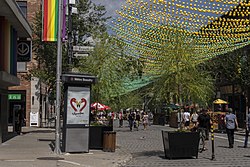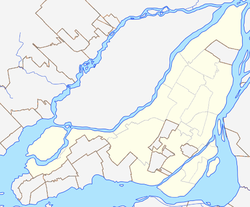
A gay village, also known as a gayborhood, is a geographical area with generally recognized boundaries that is inhabited or frequented by many lesbian, gay, bisexual, transgender, and queer (LGBTQ) people. Gay villages often contain a number of gay-oriented establishments, such as gay bars and pubs, nightclubs, bathhouses, restaurants, boutiques, and bookstores.

Outremont is an affluent residential borough (arrondissement) of the city of Montreal, Quebec, Canada. It consists entirely of the former city on the Island of Montreal in southwestern Quebec. The neighbourhood is inhabited largely by Francophones, and is also home to a Hasidic Jewish community. Since the 1950s, Outremont has been mostly residential, but some streets such as Van Horne, Bernard and Laurier have many commercial buildings.

Notre-Dame-de-Grâce, commonly known as NDG, is a residential neighbourhood of Montreal in the city's West End, with a population of 166,520 (2016). An independent municipality until annexed by the City of Montreal in 1910, NDG is today one half of the borough of Côte-des-Neiges–Notre-Dame-de-Grâce. It comprises two wards, Loyola to the west and Notre-Dame-de-Grâce to the east. NDG is bordered by four independent enclaves; its eastern border is shared with the City of Westmount, Quebec, to the north and west it is bordered by the cities of Montreal West, Hampstead and Côte-Saint-Luc. NDG plays a pivotal role in serving as the commercial and cultural hub for Montreal's predominantly English-speaking West End, with Sherbrooke Street West running the length of the community as the main commercial artery. The community is roughly bounded by Claremont Avenue to the east, Côte-Saint-Luc Road to the north, Brock Avenue in the west, and Highway 20 and the Saint-Jacques Escarpment to the south.

Church and Wellesley is an LGBT-oriented enclave in Toronto, Ontario, Canada. It is roughly bounded by Gerrard Street to the south, Yonge Street to the west, Charles Street to the north, and Jarvis Street to the east, with the core commercial strip located along Church Street from Wellesley south to Alexander. Though some LGBT-oriented establishments can be found outside this area, the general boundaries of this village have been defined by the Gay Toronto Tourism Guild.

Beaudry is a Montreal Metro station in the borough of Ville-Marie, in Montreal, Quebec, Canada. It is operated by the Société de transport de Montréal (STM) and serves the Green Line. It is in Montreal's Gay Village, part of the Centre-Sud district. Although part of the original network of the Metro, it opened two months after the rest of the network, on December 21, 1966.

Divers/Cité was an LGBT multidisciplinary arts and music festival taking place each year in the heart of Montreal, since 1993. A week-long avant-garde event in the heart of downtown Montreal and in Montreal's Gay Village area held usually on the end of July and beginning of August every year, it was open to all audiences, gay and heterosexual, including many free events.

Crescent Street is a southbound street in downtown Montreal, Quebec, Canada. Running perpendicular to Saint Catherine Street, Crescent Street descends from Sherbrooke Street south to René Lévesque Boulevard.

Sainte-Catherine Street is the primary commercial artery of Downtown Montreal, Quebec, Canada. It crosses the central business district from west to east, beginning at the corner of Claremont Avenue and de Maisonneuve Boulevard in Westmount, and ending at the Grace Dart Extended Care Centre by Assomption metro station, where it folds back into Notre-Dame Street. It also traverses Ville-Marie, passing just east of Viau in Mercier–Hochelaga-Maisonneuve. The street is 11.2 km long, and considered the backbone of Downtown Montreal.

Le Plateau-Mont-Royal is a borough (arrondissement) of the city of Montreal, Quebec, Canada.
Quebec English encompasses the English dialects of the predominantly French-speaking Canadian province of Quebec. There are few distinctive phonological features and very few restricted lexical features common among English-speaking Quebecers. The native English speakers in Quebec generally align to Standard Canadian English, one of the largest and most relatively homogeneous dialects in North America. This standard English accent is common in Montreal, where the vast majority of Quebec's native English speakers live. English-speaking Montrealers have, however, established ethnic groups that retain certain lexical features: Irish, Jewish, Italian, and Greek communities that all speak discernible varieties of English. Isolated fishing villages on the Basse-Côte-Nord of Quebec speak Newfoundland English, and many Gaspesian English-speakers use Maritime English. Francophone speakers of Quebec also have their own second-language English that incorporates French accent features, vocabulary, etc. Finally, the Kahnawake Mohawks of south shore Montreal and the Cree and Inuit of Northern Quebec speak English with their own distinctive accents, usage, and expressions from their indigenous languages.

Saint Denis Street is a major north–south thoroughfare in Montreal, Quebec.
Priape is a privately held Canadian company, headquartered in Montreal, Quebec. Priape owned and operated several retail stores specializing in DVDs, books, clothing, leather, sex toys, and other products that appeal to the gay consumer.

The Centre-Sud is a neighbourhood located in the easternmost edge of the Ville-Marie borough of the city of Montreal.

Fierté Montréal, also called Montreal Pride, is an annual LGBT pride festival in Montreal, Quebec. The event was founded in 2007 at the initiative of Montreal’s LGBTQ+ communities after the city's prior Pride festival, Divers/Cité, repositioned itself as a general arts and music festival.
Although same-sex sexual activity was illegal in Canada up to 1969, gay and lesbian themes appear in Canadian literature throughout the 20th century. Canada is now regarded as one of the most advanced countries in legal recognition of lesbian, gay, bisexual, and transgender (LGBT) rights.

La Petite-Patrie is a neighbourhood of Montreal, Quebec, Canada. It is located in the borough of Rosemont–La Petite-Patrie.

The Red-Light District of Montreal, Quebec, Canada was formerly centred on the intersection of Saint Laurent Boulevard and Saint Catherine Street in the borough of Ville-Marie.

Librairie L'Androgyne was a gay, lesbian, feminist bookstore in Montreal, Quebec, Canada, active from 1973 to 2002.

The ongoing COVID-19 pandemic has highlighted inequities experienced by marginalized populations, and has had a significant impact on the LGBT community. Gay pride events were cancelled or postponed worldwide. More than 220 gay pride celebrations around the world were canceled or postponed in 2020, and in response a Global Pride event was hosted online. LGBTQ+ people also tend to be more likely to have pre-existing health conditions, such as asthma, HIV/AIDS, cancer, or obesity, that would worsen their chances of survival if they became infected with COVID-19. They are also more likely to smoke.

















